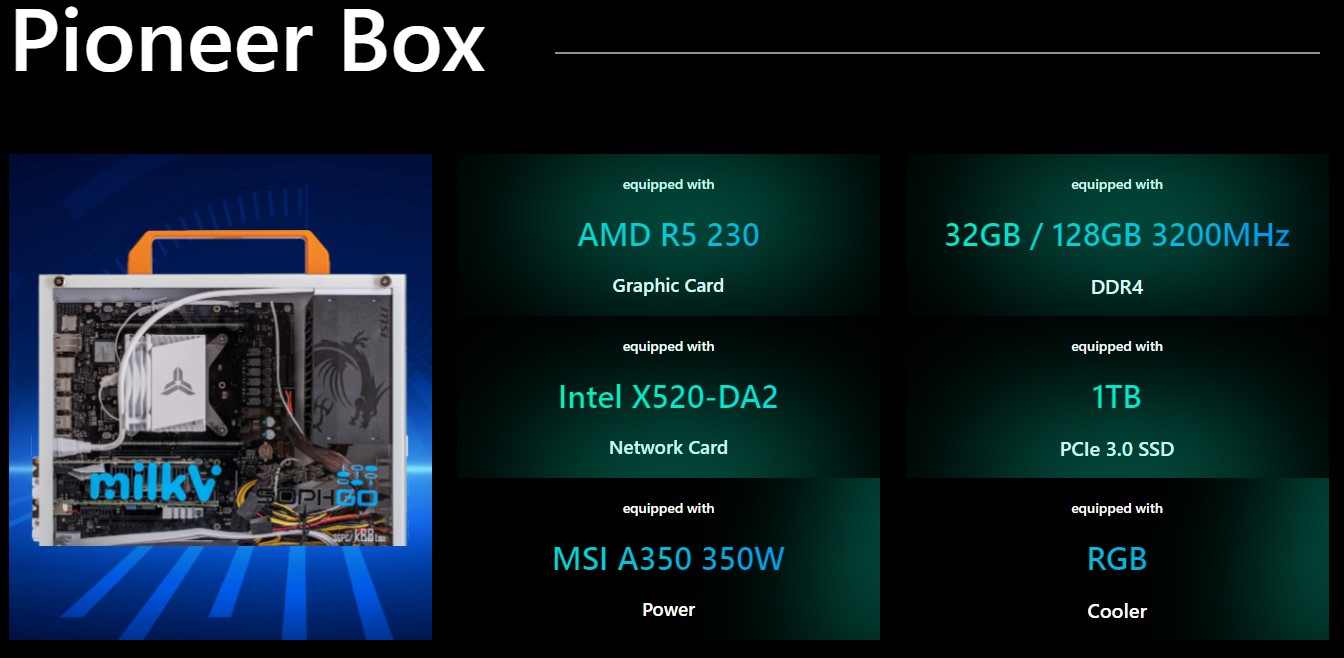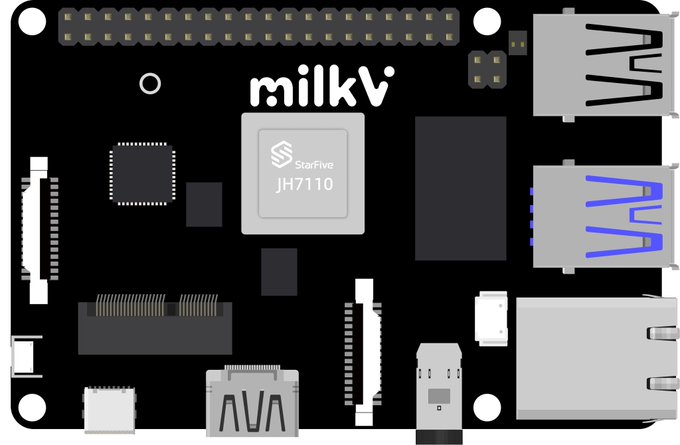Milk-V Offers a Trio of RISC-V Raspberry Pi Alternatives
Milk-V offers its own RISC-V based alternatives

Milk-V, a Chinese startup, seems to building a new RISC-V powered line of computers starting with a trio of boards. The $9 Milk-V Duo looks like a Raspberry Pi Pico. There's also Raspberry Pi shaped quad-core board and the current cream of the crop: a micro ATX system called the Milk-V Pioneer.
Milk-V Pioneer
The top-of-the-line Pioneer comes in a micro ATX form factor and is the most "PC" looking board in the lineup. The larger size of the Pioneer allows for more power than other boards and provides great expansion possibilities.
| SoC | Sophon SG2042 |
| Row 1 - Cell 0 | 64 T-Head XuanTie C920 64-bit CPU at 2 GHz |
| RAM | 4 x Slots |
| Row 3 - Cell 0 | Upto 128GB DDR4 3200 MHz |
| USB | 8 x USB 3.2, USB Header |
| Storage | 3 x PCIe x16 Slot(PCIe 3.0 x8) |
| Row 6 - Cell 0 | 5 x SATA |
| Row 7 - Cell 0 | Micro SD |
| Expansion | 2 x PCIe x16 |
| Power | 24P ATX power connector |
If you don't want to spec your own Pioneer, then the Pioneer Box is a ready-to-use RISC-V PC that provides between 32 and 128GB of RAM, a 1TB NVMe SSD, an Intel X520-DA2 network card, and two 10Gbps SFP ports. GPU duties fall to the AMD R5 230 — not a GPU on our list of best GPUs, but it'll get the job done. Power is provided by an MSI A350 350W PSU.
Operating system support appears to be largely Linux based, with Fedora, Debian, Ubuntu, Arch, and Deepin being touted.
For now there is no price for this board — all we have is a Crowd Supply page stating that the project is launching soon. Remember that crowdfunding a project is not a guarantee of receiving a finished product. Backing a crowdfunded project is akin to an investment: you believe in the project and want it to succeed, but you are not purchasing a retail product.
Milk-V Quad Core
Coming soon…The Quad-Core #riscv #sbc @risc_v Guess what it's called and leave your answer in the comments section along with the price you're looking forward to! pic.twitter.com/JcVDfyexqTMay 22, 2023
Right now, this board has no official name, nor do we have any official specs. All that we can discern from the single tweet is that it is powered by a JH7110 RISC-V and it appears to have a similar layout to the Raspberry Pi 3B+. Two USB 2.0 ports, two USB 3.0 ports, an Ethernet (Gigabit?) port, as well as one HDMI port, a USB powerport, CSI and DSI, and a 40 pin GPIO. There also seems to be a PoE header between the GPIO and USB ports. Hidden in the center of the board seems to be an M.2 slot, for storage or connectivity.
| SoC | StarFive JH7110 |
| Row 1 - Cell 0 | RISC-V U74 Quad-core 64-bit RV64GC ISA SoC |
| Row 2 - Cell 0 | 2MB L2 cache and S7 core, operating frequency up to 1.5GHz |
| RAM | 4/8GB LPDDR4 |
Milk-V Duo
The Milk-V Duo is a $9 RISC-V computer which bears a striking resemblance to our favorite microcontroller, the Raspberry Pi Pico. Where the Duo beats the Pico is that we have a Linux OS and 1GHz RISC-V CPU.
Get Tom's Hardware's best news and in-depth reviews, straight to your inbox.
| SoC | SOPHGO CV1800B |
| Row 1 - Cell 0 | Dual-Core RISC-V CPU up to 1GHz |
| RAM | 64MB RAM |
| Networking | Provides 10/100Mbps Ethernet via optional add-on board |
| Storage | Micro SD card |
| Power / Data | USB C |
| Camera | CSI camera socket |
With a 40 pin GPIO that looks like a drop-in replacement for the Raspberry Pi Pico, the Duo could turbo-charge your microcontroller projects with a full Linux or RTOS based operating system. GPIO compatibility will depend on the logic level of the board. From what we can see in the schematics this is a 3v3 logic level, so it should work with some of the best add-ons for the Pico.
The glaring omission from the Duo is onboard connectivity. We've taken the Raspberry Pi Pico W's Wi-Fi and Bluetooth for granted so to have these missing on the Duo is an issue. You can purchase an additional Ethernet board which connects to the Duo via five pins on the short end of the board. That'll do for many projects, but it is another wire to build into a project.
The $9 Milk-V Duo is not yet available for purchase, so for now you'll need to keep your eyes on the official page to learn when it will be released.

Les Pounder is an associate editor at Tom's Hardware. He is a creative technologist and for seven years has created projects to educate and inspire minds both young and old. He has worked with the Raspberry Pi Foundation to write and deliver their teacher training program "Picademy".
-
Findecanor The SiFive U74 core in the RPi-format SBC is RV64GC with the most useful parts of Bitmanip: Zba and ZbbReply
From a little bit of googling, I found out that the Milk-V Duo's SoC has the T-Head XuanTie C906 core.
Both the C920 and C906 are RV64GC, and also implement the 0.7.1 draft of the Vector extension (!) extended with 16-bit FP support.
No Bitmanip, but instead T-head's own "thead" extension which has a lot of overlap with Zba and Zbb.
BTW. Because there are several 64-bit RISC-V microcontrollers with relatively little memory on the way, there's a special Linux profile in development that uses 32-bit addressing to save memory. -
bit_user It's not clear from the article, but the top-spec micro-ATX board appears to have 64 cores. Should be interesting, though I'm not expecting it to reach Ampere Altra performance levels. Possibly a good development platform for RISC-V porting & optimization efforts, though.Reply



